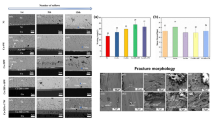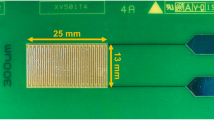Abstract
New halide-free fluxes are becoming more prevalent in electronic packaging; however, their efficacy and reactive behavior with conventional solders has not been well characterized. In this work, we examine nonaqueous halide-free flux reactions of tin (Sn)-based solder surfaces using electrochemical methods. Cyclic voltammetry was used to study reactions of Sn(II) and Sn(IV) species, x-ray photoelectron spectroscopy (XPS) was used to study surface chemistry, and chronopotentiometry was used to quantify equilibrium constants of Sn–carboxylic complexes. Reactions were investigated using carboxylic acid solutions such as adipic acid or maleic acid in polyethylene glycol. Carboxylic acid-based fluxes are practically inactive toward SnO2 removal at room temperature (25°C); however, some species are capable of removing the oxides at temperatures as high as 180°C and at pH as low as 0.1. XPS results suggest the H+ activity of the carboxylic acid is the key to removing SnO2 on Sn-based solder surfaces. Equilibrium coefficients and potential-pH diagrams are given to elucidate the influence of pH on Sn surfaces.
Similar content being viewed by others
References
P.S. Ho, G.T. Wang, M. Ding, J.H. Zhao, and X. Dai, Microelectron. Reliab. 44, 719 (2004).
B. Vandevelde, M. Gonzalez, P. Limaye, P. Ratchev, and E. Beyne, Microelectron. Reliab. 47, 259 (2007).
K. Zeng and K.N. Tu, Mater Sci Eng R-Rep 38, 55 (2002).
W. Yang, R.W. Messler, and L.E. Felton, J. Electron. Mater. 23, 765 (1994).
K.J. Zeng, R. Stierman, T.C. Chiu, D. Edwards, K. Ano, and K.N. Tu, J Appl Phys 97, 024508 (2005).
J.H.L. Pang, T.H. Low, B.S. Xiong, L.H. Xu, and C.C. Neo, Thin Solid Films 462, 370 (2004).
L.C.X. Zou and C. Hunt, J. Mater. Res. 23, 2622 (2008).
S.P. Yu, C.L. Liao, M.H. Hon, and M.C. Wang, J Mater Sci 35, 4217 (2000).
S.P. Yu, H.J. Lin, M.H. Hon, and M.C. Wang, J. Mater Sci. 11, 461 (2000).
T. Singler, S. Meschter, and J. Spalik, Handbook of Lead-Free Solder Technology for Microelectronic Assemblies, ed. K. Puttlitz and K. Stalter (New York: Marcel Dekker, Inc., 2004),
G.C. Jasbir Bath, T. Jensen, R. Michalkiewicz, and B. Toleno, Paper presented at the IPC APEX Halogen-Free Packaging (Las Vegas, NV, 2011).
G.Y. Qu, S.S. Vegunta, K. Mai, C.J. Weinman, T. Ghosh, W. Wu, and J.C. Flake, J. Electrochem. Soc. 160, E49 (2013).
N.A. Lange and J.A. Dean, Lange’s Handbook of Chemistry (New York: McGraw-Hill, 1973).
C.F. Han, Q. Liu, and D.G. Ivey, Electrochim. Acta 53, 8332 (2008).
B.N. Stirrup and N.A. Hampson, Surf Technol 5, 429 (1977).
L.C. Bichara, M.V.F. Bimbi, C.A. Gervasi, P.E. Alvarez, and S.A. Brandan, J. Mol. Struct. 1008, 95 (2012).
J. Jarosz and C. Sinicki, Comptes Rendus De L Academie Des Sciences Serie Ii 292, 793 (1981).
A.J. Bard and L.R. Faulkner, Electrochemical Methods: Fundamentals and Applications (New York: Wiley, 1980).
H. Cho and Y.H. Yun, Ceram. Int. 37, 615 (2011).
M. Seruga, M. MetikosHukovic, T. Valla, M. Milun, H. Hoffschultz, and K. Wandelt, J. Electroanal. Chem. 407, 83 (1996).
M. Pourbaix, Atlas of Electrochemical Equilibria in Aqueous Solutions (Oxford: Pergamon Press, 1966).
S.S. Abd El Rehim, H.H. Hassan, and N.F. Mohamed, Corros. Sci. 46, 1071 (2004).
A.S. Tselesh, Thin Solid Films 516, 6253 (2008).
G.H. Biego, H. Biaudet, M. Joyeux, and G. Debry, Sci Des Aliments 16, 623 (1996).
Y. Mino, J. Health Sci. 52, 67 (2006).
L. Perring and M. Basic-Dvorzak, Anal. Bioanal. Chem. 374, 235 (2002).
I. Trandafir, V. Nour, and M.E. Ionica, J Environ Prot Ecol 11, 49 (2010).
I. Trandafir, V. Nour, and M.E. Ionica, Pol J. Environ. Stud. 21, 749 (2012).
Y.F. Wu and T.H. Tsai, Microelectron. Eng. 84, 2790 (2007).
C.B. Castells, C. Rafols, M. Roses, and E. Bosch, J. Chromatogr. A 1002, 41 (2003).
Author information
Authors and Affiliations
Corresponding author
Rights and permissions
About this article
Cite this article
Qu, G., Weinman, C.J., Ghosh, T. et al. Nonaqueous Halide-Free Flux Reactions with Tin-Based Solders. J. Electron. Mater. 44, 1144–1150 (2015). https://doi.org/10.1007/s11664-015-3635-6
Received:
Accepted:
Published:
Issue Date:
DOI: https://doi.org/10.1007/s11664-015-3635-6




